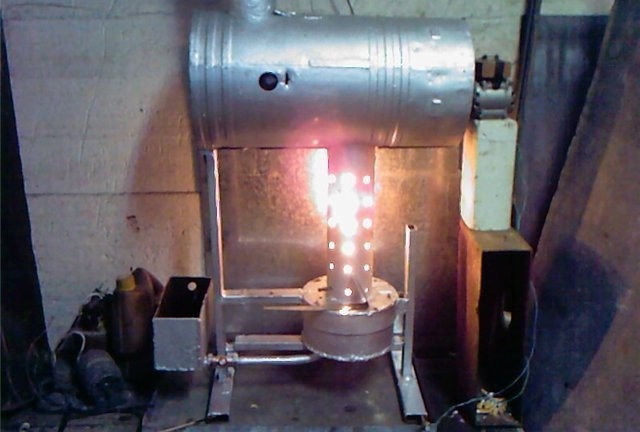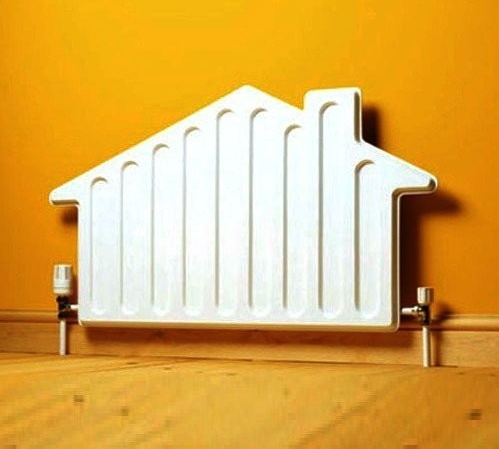Options for saving electricity: how to increase the energy efficiency of your home
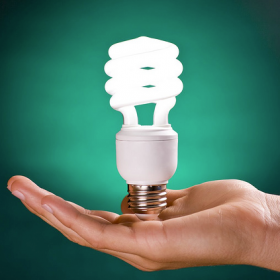
To heat a private house with the help of electricity is quite expensive, but very convenient. Reliable equipment, a high level of security, ample opportunities for automation, a wide selection of models with various functions - all this encourages homeowners to install electric heating boilers. Almost immediately, the most important question arises: how to reduce energy costs and save on heating?
Saving electricity in a private house is a whole complex of measures that include not only the heating system, but also many other aspects, in particular, the effective use of various household appliances. To reduce the number of kilowatts running fast, it is recommended:
- check the degree of thermal insulation of the building and correct defects;
- install a multi-tariff meter;
- audit the state of the power grid;
- find out exactly how much energy is consumed specifically for heating, etc.
After these and similar moments have been clarified, it is necessary to draw up a work plan to improve the energy efficiency of the building and assess the upcoming costs. Some activities can be quite expensive. Therefore, it is necessary to ensure that the effect of savings is not absorbed in attempts to achieve this same savings.
Content
Proper insulation is the key to savings
Warming a private home is a necessity that every homeowner is well aware of. The range of thermal insulation materials and their applications is wide enough. Therefore, if the house still stands “without clothes”, it must be insulated. If thermal insulation work was carried out earlier, you should check the quality of insulation, identify weaknesses and eliminate all shortcomings. It is necessary to pay attention to the thermal insulation of walls, as well as windows and doors. It is necessary to identify all the “cold bridges” available in floors or in the floor, and carefully isolate them.
Sometimes problems with thermal insulation at home are not obvious. Heat can escape through the front door, which should be double. Many kilojoules can be saved by protecting the landing from the cold. Sometimes heat flows through holes in a leaky duct. Such small moments can help significantly reduce energy costs. Although the main energy consumption in a private house is usually associated with heating and hot water supply, improper thermal insulation can absorb up to 50% of all consumed electricity.
Another important point: the correct distribution of heat inside the building.If some rooms warm up too much, while in others the air temperature remains low, the heating equipment will work with overload. In this case, it is necessary to diagnose weak points (for example a thermal imager) and work on the efficiency of using the heating system.
We bring to your attention an online calculator for calculating the heat loss of a rectangular room, maybe it will be useful to you:
The magic of a two-tariff electric meter
Many homeowners praised the effectiveness of dual tariff meters. These devices take into account the amount of electricity consumed at different times of the day. The daily rate is higher than the night one, so the kilowatts spent at night are paid less. However, the size of tariffs and the procedure for their accounting vary depending on the region.
Of course, at night, energy consumption is reduced. Some homeowners heat the house well at night, trying to minimize daily energy consumption. However, this method does not particularly contribute to creating a comfortable atmosphere in the house. It is much more convenient to use a special heat accumulator, which accumulates cheaper energy at night, and transfers it to the system during the day, depending on the needs of the house.
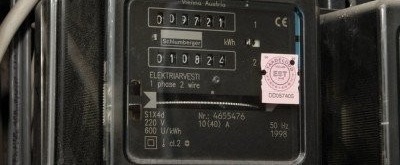
A two-tariff or multi-tariff electricity meter is designed to record electricity consumption at different times of the day, which allows you to pay kilowatts consumed at night at a lower tariff
The only problem that arises with the heat accumulator is the high price of industrial models of these devices. Many folk craftsmen make such devices on their own. To automate the inclusion of heating elements, you can use the timer, the flow of hot water from the battery tank is also automated.
Really noticeable energy savings when using the double tariff can be obtained only with significant amounts of night power consumption.
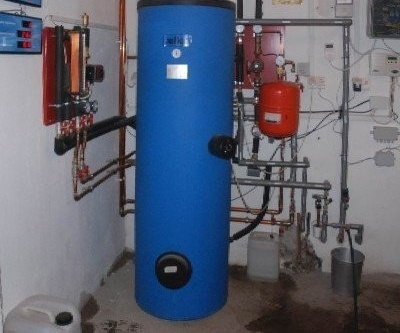
Using a special heat accumulator allows you to heat water for heating at night and pay for electricity at a cheaper “night” rate
Interesting information on the use of multi-tariff electricity meters is contained in the video material:
There are no miracles - how people are deceived
On the pages of the media and on the Internet, advertisements about wonderful devices are widely distributed that help to significantly save energy. It is enough to include such a device in the network, the incredible will happen: the cost of electricity will be reduced by two, or even ten times! In practice, it turns out that a situation where not the consumer owes the state for electricity, but the state owes to the consumer, is possible only in the old Odessa joke.
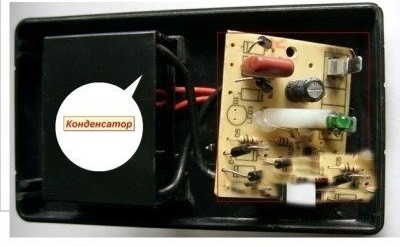
If you open the "miracle device" to save energy, inside you will find a rectifier for the LED and a capacitor. It is impossible to reduce energy consumption with such a device
The fact is that such devices during operation compensate only the reactive power of electrical energy. When accounting for consumable data, this indicator is not taken into account, therefore, the number of consumed kilowatts on the meter will accumulate at the same speed.
Inside this so-called “device” is a rectifier that provides power to the LED, and a capacitor filled with wax. Hoping for any savings using such a device would be unreasonable.
Find the main "burners" of energy
Sometimes the high energy consumption in a private house is not associated with high tariffs or poor thermal insulation. The problem may be the condition of the home electrical network or the improper use of household electrical appliances. In addition, among active consumers of electricity may include:
- pumps for water supply, heating, irrigation, etc .;
- ventilation system;
- additional heating in the form of a “warm floor”;
- a power tool that is used when working on a site, etc.
A considerable part of the energy can be absorbed by devices that are constantly in the background: computer equipment, televisions, air conditioners, microwaves, mobile phone chargers, etc. The total energy consumption of a standard set of household appliances left in standby mode for a year can reach 350-400 kW / h. To calculate such unaccounted for "consumers" it is recommended to use RCDs - residual current devices.
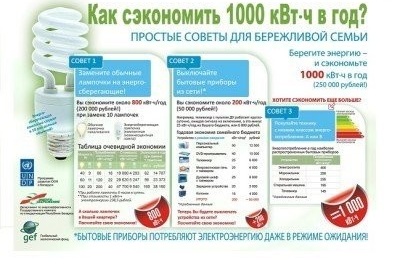
The diagram shows the infographics containing useful recommendations for saving energy through the rational use of household appliances and energy-saving lamps
A thorough audit of all power consumption in the home should be carried out. For this, it is necessary to summarize the consumer power of all electrical appliances. Data can be obtained from the technical data sheet of each specific device. If your passport is lost, help information is not difficult to find on the Internet. The resulting amount is compared with the data of the electric meter, thus revealing exactly where the kilowatts go. Sometimes it makes sense to replace an outdated appliance with an analog with a higher energy class.
If all household appliances are turned off and the power consumption remains high, check the condition of the wiring. Electricity can flow through a bare wire in contact with the wall. Such a situation not only leads to unnecessary costs, but also is life threatening.
Some helpful suggestions
Special attention deserves the condition of heating radiators. On each of them it is recommended to install a special thermostatic valve, which will allow you to adjust the temperature for each room in the house. It does not make sense to maintain the same temperature in the closet or in the pantry as in living quarters. Since the kitchen is partially heated by a stove and other appliances, it will be comfortable here at 18 degrees Celsius, although it is recommended to maintain an air temperature of 21 degrees in the bedroom. So, if you reduce the air temperature in the room by only one degree, you can save about 6% of the thermal energy needed to heat this room.
Radiators must be checked in a timely manner for trapped in the air system. The battery will warm up much more efficiently if the airing of the system is eliminated. It is recommended to ensure free air circulation around the radiators. To do this, remove decorative screens, curtains, and other objects that block them. This way you can save up to 20% of heat.
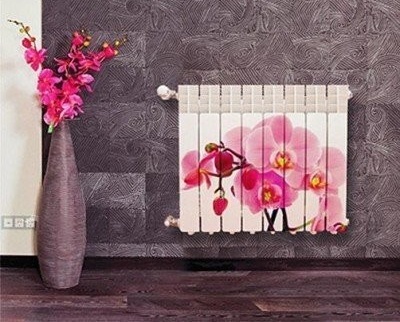
Elegant decor applied to the heating radiator turns the battery into a stylish interior detail. In this case, a decorative screen is not needed, and heating costs will decrease
Another useful tip: to improve the thermal insulation of niches in which radiators are installed so that as much heat as possible remains in the room. Additionally, heat-reflecting screens are recommended behind the battery. The consumption of thermal energy will decrease by 4%.
Properly organized ventilation can also be significant for saving heat. Constant airing through a small gap between the window sashes leads to a significant overspending of thermal energy. Instead, it is recommended that you periodically open the windows periodically to thoroughly ventilate the room, after which the windows close tightly again. This measure will provide fresh air to the house and reduce heating costs.
